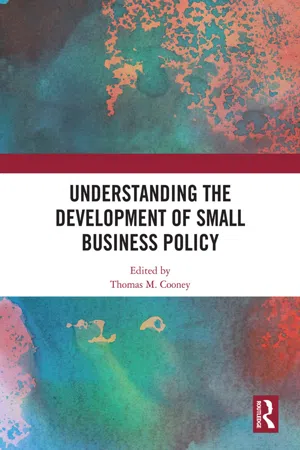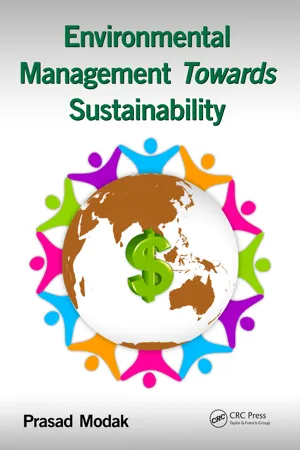Business
Government Policies on Business
Government policies on business refer to the regulations, laws, and initiatives implemented by the government to influence and control the activities of businesses within a country. These policies can cover areas such as taxation, trade, employment, environmental regulations, and industry-specific regulations. The aim is to create a stable and conducive environment for businesses to operate while also serving the broader interests of the economy and society.
Written by Perlego with AI-assistance
Related key terms
8 Key excerpts on "Government Policies on Business"
- eBook - ePub
- Martin Perry(Author)
- 2015(Publication Date)
- Business Expert Press(Publisher)
Chapter 1Environmental Policy: Government and Business AgendasIn the broadest sense, policy can be thought of as the set of principles and intentions used to guide decision making.1 This is a useful interpretation as it draws attention to the way people as well as organizations make policy-informed decisions and how policy exists when action is not taken as well as when positive decisions to change behavior are taken. Nonetheless, this book focuses on perhaps a more generally understood interpretation of policy: initiatives designed by government agencies intending to achieve specific ends through efforts enshrined in public policy programs. These deliberate efforts are by and large responses to issues that are deemed sufficiently serious to justify efforts to curb individual and organizational behaviors that would occur otherwise in the absence of the policy intervention, typically with goals and objectives to be achieved over a specified time frame. Environmental policy as discussed in this book is concerned with the principles and intentions of policy programs that aim to protect and enhance the state of the physical environment and natural ecosystems. This encompasses a wide range of concerns, including the designation of national parks, wildlife protection, standards governing air and water quality, and the controls placed on individual land users. The particular interest is in environmental policy as it affects the contemporary concern with sustainability and that is directly concerned with engineering changes in business behavior.Sustainability is the idea that today’s population should limit its use of resources to that which at least ensures that future populations inherit a world of no lesser quality and environmental abundance.2 Sustainability has modified the scope of environmental policy in at least three ways. First, it has broadened the issues to which policy is applied by increasing the efforts to address the so-called global commons or those aspects of the environment that are shared between all parts of the world or at least among large numbers of nations.3 Efforts to control the emissions of carbon dioxide and other gases associated with climate change are a prime reflection of this, together with international efforts to control a previously unrestricted activity (releasing greenhouse gases into the environment). Second, it has encouraged environmental issues to be addressed in a more integrated fashion than they once were. This is partly captured by the idea of transferring control efforts from the end-of-the-pipeline to their ultimate source in the way goods and services are designed, distributed, and disposed of. It is reflected in such concepts as life cycle analysis, enterprise thinking, and ecoeffectiveness.4 Third, being associated with what some have called “third wave environmentalism,”5 sustainability has changed the extent to which the environment is presented as a limiting factor on business. In the 1970s, the environment was presented as placing a “limit to growth” that required business and people to modify their behavior in fundamental ways or risk massive upheaval as the limits of resource availability were reached. With sustainability, the message is that green growth is possible by shifting away from a dependence on resource-intensive technologies and limiting the use of nonrenewable resources in favor of clean technology, renewable sources of energy, smart networks, and related innovations. The broad claim is that with green growth it should be possible to decouple growth in income per capita from environmental performance.6 - eBook - ePub
- Keith Porter, Paul Smith, Roger Fagg(Authors)
- 2007(Publication Date)
- Routledge(Publisher)
Government policy
DOI: 10.4324/9780080492810-12Chapter objectives
In this chapter you will:- Review major policy developments and debates in economic, industrial and education policy
- Consider the implications of developments in these fields for markets for goods and services, and for employment and labour markets
- Assess the major ways in which organizations seek to influence the development of government policy.
Chapter introduction
In this chapter, we examine those areas of government activity that impact directly on organizations and the activities of HR professionals in particular. We begin our review of economic policy by focusing on competition policy and then proceed to consider employment policy. The focus then shifts to industrial policy, followed by educational policy. We conclude with an examination of how the direction of government can be influenced by lobbying activities.12.1 Government policy to regulate the competitive environment
Sometimes firms will collude by agreeing on prices, market share or advertising expenditure. This collusion reduces the uncertainty faced by these firms. Formal collusive agreements are known as cartels, which are prohibited in Britain under restrictive trade practices legislation, unless the firms involved can prove to the Restrictive Practices Court that their agreement is in the public interest.12.1.1 The ‘public interest' and competition policies
The real world is characterized by imperfect markets, with firms having different degrees of market power. Governments consider the extent to which this market power will be in the public interest when they develop legislation to deal with monopolies and oligopolies. Market power, from the consumer's point of view, seems inevitably to be undesirable, because firms are able to exploit the powerless consumer. The greater the firm's power, the higher will be its prices relative to its costs of production. However, this is not necessarily the case as firms may still charge a relatively low price because of their economies of scale; furthermore, they may use their profits for investment and research and development, with the consumer benefiting from better products at lower prices. - Jay Mitra(Author)
- 2013(Publication Date)
- Routledge(Publisher)
The focus of this chapter is on public policy and entrepreneurship. Reference here is to policies developed by the governments of sovereign states. Government policy has considerable implications for business creation, growth and development and the ability of businesses to be innovative in particular circumstances. Creating suitable conditions for new businesses to start and thrive, enabling existing firms to grow by developing new products and services in new markets through appropriate tax policies, supportive physical infrastructure, provision for training and information, promoting incubation facilities, research and development facilities and entrepreneurship education are just some of the means by which governments can encourage entrepreneurship in a country and its regions. The chapter explores the scope and purpose of entrepreneurship policy, its principal features, how and why policy has evolved, the connection between economic development entrepreneurship, and some of the key questions that plague observers, analysts and decision makers. The approach is theoretical, with appropriate references to practical considerations and examples.The types of policies governments create and implement will depend on the stage or circumstances of development of a country and its particular environment. There may well be differences within countries demanding focused and differentiated policy for different regions, each of which has its particular local environment. This chapter should be read in conjunction with Chapter 11 (‘Entrepreneurship, Innovation and Economic Development’) and Chapter 6 (‘The Entrepreneurial Environment’).Part I: The Emergence of Government Policy for EntrepreneurshipPolicy for entrepreneurship and economic growth has enjoyed a rather fragmented and unplanned journey. It has slipped in and out of governmental reckoning as circumstances have changed with times. The bursting of the dot.com bubble and the more recent shenani-gans of financiers experimenting with different forms of alleged financial innovations have made the public and policy makers both wary and curious about the positive role of entrepreneurship. What was the vogue of the 1990s, as evinced in books on ‘daring visionaries’, videos and movies on the ebb and flow of start-up ventures (Hart, 2003) in Silicon Valley, Bangalore, Munich, Guandong, London and Goteburg, and the apparently ready availability of venture capital, business angel money and private equity, seems to have evaporated and given way now to a mix of home-spun and informed scepticism. The large brand names and their larger-than-life Chief Executive Officers, regained momentum almost as if to cor-roborate Schumpeter’s (1942) second phase view that innovation and entrepreneurship were better placed in the hands of larger corporations. In other words, ‘entrepreneurship’ has suddenly acquired a rather questionable status, if not a bad name! Additionally, the association of entrepreneurship with small businesses, a long-held assumption, has begun to be questioned. In some quarters the idea of the apparent security and capacity of larger firms to innovate and be entrepreneurial has gained renewed momentum.- Thomas M. Cooney(Author)
- 2020(Publication Date)
- Routledge(Publisher)
Of course, there are good reasons why one would expect some variation between regions and countries in the types and strengths of policy intervention used, on the basis that the level of entrepreneurship itself can vary considerably between regions and between countries. Indeed, the attitude and stance of the population towards entrepreneurs also varies considerably at a regional and national level. Within this context, one would expect that where the level of entrepreneurship is low, more attention needs to be paid to the types of measures that are designed to promote it. In the so-called broad view of entrepreneurship policy, the central proposition is that the development of entrepreneurship is heavily influenced by the role that government plays in the macro-economic environment in which business is conducted. Of course, this argument applies rather more in mature market economies than it does in developing, or emerging, market economies, but nevertheless, government policies and actions impact on such indicators as exchange rates and interest rates which can have major impacts on the environment in which business is conducted.A second element in the so-called broad view of entrepreneurship policy is identifying where government legislation and regulations impact on businesses, which is often argued to have a differential impact on businesses of different sizes (Kitching, 2006; van Stel, Storey, & Thurik, 2007). This is essentially a proportionality effect, with the impact on smaller businesses being stronger than in the case of larger enterprises where there may be an increasing managerial division of labour. This includes specialists taking care of some areas (such as health and safety), which in a firm of less than 20 employees will typically be one of the many responsibilities of the business owner. The argument here is not that government is ‘out to get’ the entrepreneur but generally the impact of its interventions include effects that were not intended.The next influence is through the business tax regime, particularly in the case of economies that are at a lower level of development. For example, if one takes the case of the new member states of the European Union, these are countries which have operated under central planning in the past. In these countries, the employer’s responsibility for social security payments in the early years of transformation was penal. The main problem was social security payments which during the Soviet period were the responsibility of state-owned enterprises. This meant that when the Soviet Union collapsed, many people were left without social security for a period. From a policy perspective, the problem was that there was no accumulated fund that could be used to kick-start the process of establishing a more centralized social security system and therefore the fund had to be built up from current income. The result was that it was almost impossible for small businesses to operate totally within the law and be profitable at that time. Consequently, many small businesses were forced into the informal sector for at least part of their activities.- eBook - ePub
Business, Society and Government Essentials
Strategy and Applied Ethics
- Robert N. Lussier, Herbert Sherman(Authors)
- 2022(Publication Date)
- Routledge(Publisher)
39 Are the goals of the public policy being met? If there are complaints about the public policy, government can change the policy. For example, the Civil Rights Act of 1972 was changed in 1991.Industrial Policy. One type of public policy directly related to business is industrial policy. Industrial policy is government action directing resources to the development of specific industries. Most industries have specific regulations based on their unique operations. The government also helps industries in time of need. For example, when the GM and Chrysler Corporation and many firms in the financial industry were faced with bankruptcy, the government bailed them out. After the World Trade Center attack on 9/11/2001, the airline industry was crippled, and Congress passed a bailout program. During the global pandemic, the US government gave money to all types of businesses to help them prevent going out of business.The government also protects natural monopolies and some industries against foreign competition to make them more competitive by placing tariffs and quotas on certain foreign imports. The US Federal Communications Commission designated five Chinese tech firms as posing an “unacceptable risk” to national security as part of a larger policy move to secure US communications.40Changes in public policy also result in shifts in the types of activities businesses pursue. In the global economy, there is a trend to move away from fossil fuels to clean energy. As a result, global auto makers (Toyota, VW, GM) are gradually moving to producing only electric cars, and oil companies (Shell, BP, Exxon-Mobile) are diversifying into clean energy. This trend also creates opportunities for e-car charging stations, which will gradually reduce the number of gas stations.Types of Public Policy. There are two major types of public policy: economic and social.Economic Policy. Government economic policies play an important role in economic development through financial markets.41 - eBook - ePub
Social Policy 3E
Theory and Practice
- Spicker, Paul(Authors)
- 2014(Publication Date)
- Policy Press(Publisher)
The field of social policy relates to a complex constellation of policies, institutions and actions. Governments operate and manage a range of practical activities. The broad areas of policy are commonly divided into economic policy, foreign policy and ‘domestic’ policy. ‘Policy’ here has to be taken in a fairly general sense; government policy in this sense is whatever government happens to do, or not to do. In those terms, social policy might be seen as a sub-category of domestic policy, along with areas like civil law, culture and environmental policy. This conventional distinction does not work particularly well, however; it seems clear that aspects of social policy cut across all these fields (including economic and foreign policy). Equally, social policy is wider than government policy alone: government plays an important role, but social policy is not just about the work of the state.The area of activity which is run directly by government is referred to as the ‘public sector’. This includes a wide range of activities, including for example direct economic engagement in publicly owned industries, the business of managing government, such as the civil service, and the provision of services to other agencies, like government laboratories or defence procurement. Part of the role of public sector is to provide services, but that is only part.‘Public services’ include some public sector agencies, but they also include other kinds of institutional arrangement – they are not necessarily public in the sense of being developed by governments. The provision of medical care in Europe has been heavily influenced by the position of mutual societies and occupational insurance. Public services are ‘public’ because they are developed for reasons of policy. They are intended in principle to meet the objectives of governments, donors or governing bodies – rather than the aims of purchasers, clients or producers. They are ‘services’ in the sense that they provide directly for people – roads, schools, libraries and medical care convey a direct personal benefit to the people who use them. (That is not necessarily the same sense they are used in economics, where the provision of a service is distinguished from the production of goods. Many public services are services in this sense – services like education, social work and community development are concerned with intangibles, and service delivery is a process, rather than a specific act of production.328 - eBook - ePub
- Prasad Modak(Author)
- 2018(Publication Date)
- CRC Press(Publisher)
4 Business Response Business operations play an important role in the sustainability of the planet whether it is a manufacturing, product or service business at a large, medium, or small scale.Businesses pollute the environment when the enforcement of environmental laws and standards set by authorities is non-existent or weak. They pollute to the point where the penalty for creating pollution becomes greater than the cost of pollution control. When the penalty is greater than abatement costs, businesses are forced to curb their emissions.In the recent decades, large and small businesses have taken initiatives, voluntarily, or to comply with regulations, to minimize their impact on the environment. There are various reasons why most businesses today want to comply:• Scarcity or non-availability of resources like fuels and industrial metals• Increasing regulations and environmental penalties• Inclination of employees, investors and consumers to be associated with sustainable brands• Risks to brand or business reputation4.1Impact of Government Policies and LegislationNational governments strengthened policies and regulations to impose limits on resource extraction and use, emissions of pollutants, and use of hazardous substances in manufactured products. The regulatory authorities followed precautionary and polluter pays principles (discussed in Chapter 2 ) while dealing with environmental issues arising from business operations.For instance, the European Parliament issued two Directives in 2003, Waste Electrical and Electronic Equipment (WEEE) and Restriction of Hazardous Substances (RoHS). WEEE Directive’s objective was to regulate WEEE management by prevention, maximizing reuse, recycling, and other forms of recovery of wastes to reduce disposal. The objective of the RoHS Directive was to reduce the hazardous material content in consumer products.1 Boxes 4.1 and 4.2 - eBook - ePub
Entrepreneurship, Small Business and Public Policy
Evolution and revolution
- Robert J. Bennett(Author)
- 2014(Publication Date)
- Routledge(Publisher)
A functional definition allows us to understand businesses, but policies usevarious definitions. Policies are difficult to make effective. The problems ofdefinition and effectiveness are seldom clear from government statements. Theresearch literature and established texts on policy are also not uniformly helpful.In general there has been a strong tendency for policy makers and politicians totreat entrepreneurs and small businesses as simple categories and vaunt newinitiatives as faultless recipes for economic success. Similarly, many researchauthors feed demands for intellectual support for policies that ignore full policycosts, displacement of existing firms, deadweight and dependency. It is because ofthese complexities that this book has been written. At the very least it is hoped thatyou, and policy makers, will improve over past experiences.The learning objectives of this chapter are:■ to understand the policy needs of different types of entrepreneurs and small businesses;■ understand the objectives of policies;■ understand the context for policies: the ‘business enabling environment’.WHAT ARE ENTREPRENEURSHIP AND SMALL BUSINESS POLICIES?
The public policies discussed here are explicit or targeted, and also policies that are not explicit but nevertheless impact small businesses and entrepreneurs. Examples of targeted policies are loan guarantees, support for exporters, advice and information provision. Examples of non-targeted policies
Learn about this page
Index pages curate the most relevant extracts from our library of academic textbooks. They’ve been created using an in-house natural language model (NLM), each adding context and meaning to key research topics.







